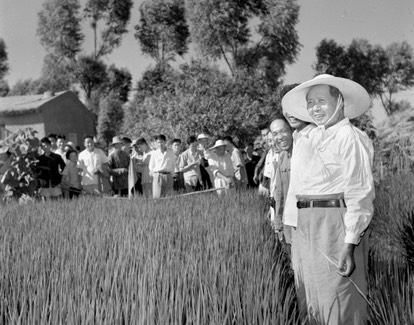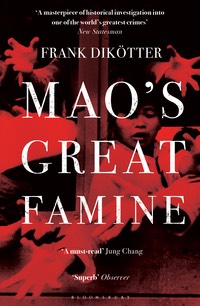Mao's Great Famine: The History of China’s Most Devastating Catastrophe is based on well over a thousand archival documents, including reports from the Public Security Bureau, minutes of top party meetings, uncensored versions of important leadership speeches, surveys of working conditions in the countryside, investigations into cases of mass murder, confessions of leaders responsible for the deaths of millions of people, inquiries compiled by special teams sent in to discover the extent of the catastrophe, reports on peasant resistance during the collectivisation campaign, secret opinion surveys, letters of complaint written by ordinary people, and much more.
What comes out of this rich and detailed dossier goes far beyond even the most pessimistic estimates. When it comes to the overall death toll, for instance, researchers so far have had to extrapolate from official population statistics. Their estimates range from 15 to 32 million excess deaths. But the public security reports compiled at the time, as well as the voluminous secret reports collated by party committees in the last months of the Great Leap Forward, show how inadequate these calculations are, pointing instead at a catastrophe of a much greater magnitude. This book shows how at least 45 million people died unnecessarily between 1958 and 1962.
Mass killings are not usually associated with the Great Leap Forward, and Mao continues to be compared favourably with Hitler, Stalin or Pol Pot. But as the fresh evidence presented in this book demonstrates, coercion, terror and systematic violence were the foundations of Maoist China. Thanks to the often meticulous reports compiled by the party itself, we can infer that between 1958 to 1962, by a rough approximation 6 to 8 per cent of those who died prematurely were tortured to death or summarily executed - amounting to at least 2.5 million people. Many other victims were deliberately deprived of food and starved to death. Even more vanished because they were too old, weak or sick to work - and hence unable to earn their keep. People were killed selectively because they were rich, because they dragged their feet, because they spoke out or simply because they were not liked, for whatever reason, by the man who wielded the ladle in the canteen. Countless people were killed indirectly through neglect, as local cadres were under pressure to focus on figures rather than on people, making sure they fulfilled the targets they were handed by the top planners.
A vision of promised abundance not only motivated one of the most deadly mass killings of human history, but also inflicted unprecedented damage on agriculture, trade, industry and transportation. Livestock declined precipitously, not only because animals were slaughtered for the export market but also because they succumbed en masse to disease and hunger - despite extravagant schemes for giant piggeries that would bring meat to every table. As everyone cut corners in the relentless pursuit of higher output, factories spewed out shoddy goods that accumulated uncollected by railway sidings. The transportation system creaked to a halt before collapsing altogether, unable to cope with the demands created by a command economy. It would have been difficult to design a more wasteful system, one in which grain rotted uncollected by dusty roads in the countryside as people foraged for roots or ate mud.
The book also documents how the attempt to leap into communism resulted in the greatest demolition of real estate in human history - by far outstripping any of the World War II bombing campaigns. Between 30 and 40 per cent of all housing was turned into rubble, as homes were pulled down to make fertiliser, to build canteens, to relocate villagers, to straighten roads, to make place for a better future beckoning ahead or simply to punish their occupants.
The natural world did not escape unscathed either. We will never know the full extent of forest coverage lost during the Great Leap Forward, but a prolonged and intense attack on nature claimed up to 50 per cent of all trees in some provinces. The rivers and waterways suffered too: throughout the country, dams and canals built by hundreds of millions of farmers at great human and economic cost were for the greatest part rendered useless or even dangerous, resulting in land slides, river silting, soil salinisation and devastating floods.
The book chronicles, often in harrowing detail, the near collapse of a social and economic system on which Mao staked his prestige. It also brings together two dimensions of the catastrophe that have so far been studied in isolation, namely what happened in the corridors of Zhongnanhai, the compound which served as the headquarters of the party in Beijing, and the everyday experiences of ordinary people. The archives bring some of the top secret meetings to light, and we see the vicious backstabbing and bullying tactics that took place among party leaders in all their rawness. The portrait that emerges of Mao himself is hardly flattering, and far removed from the public image he so carefully cultivated: rambling in his speeches, obsessed with his own role in history, often dwelling on past slights, a master at using his emotions to force his way through a meeting, and, above all, insensitive to human loss.
But the Chairman would never have been able to prevail without the backing of Liu Shaoqi and Zhou Enlai, the next two most powerful party leaders. They, in turn, whipped up support from other senior colleagues, as chains of interests and alliances extended all the way down to the village - as is documented here in compelling detail. Ferocious purges were carried out, as lacklustre cadres were replaced with hard, unscrupulous men who trimmed their sails to benefit from the radical winds blowing from Beijing.
Just as the fresh evidence from the archives shows how responsibility for the catastrophe extended far beyond Mao, the profuse documentation which the party compiled on every aspect of daily life under its rule disputes the simple idea of the people as mere victims. In contrast to the image of a strictly disciplined communist society in which errors at the top cause the entire machinery to grind to a halt, the portrait that emerges from archives and interviews is one of a society in disintegration, leaving people to resort to whatever means available to survive. So destructive was radical collectivisation that at every level the population tried to circumvent, undermine or exploit the master plan, covertly giving full scope to the profit motive that the party tried to eliminate.
As famine spread, the very survival of an ordinary person came increasingly to depend on the ability to lie, charm, hide, steal, cheat, pilfer, forage, smuggle, trick, manipulate or otherwise outwit the state. But collectivisation also forced everybody, at some point or another, to make grim moral compromises. People turned on each other, some parents stealing from their own children or selling them to strangers for a handful of grain. Routine degradations thus went hand in hand with mass destruction. Survivors were rarely heroes, as those determined to make it in a world dominated by the law of survival had to silence their moral sentiments. Understanding the extraordinary range and complexity of human behaviour in times of catastrophe is a key goal of the book, as the archives allow us to get closer to the difficult choices people made half a century ago - whether in the corridors of power or inside a peasant hut far away from the capital.

